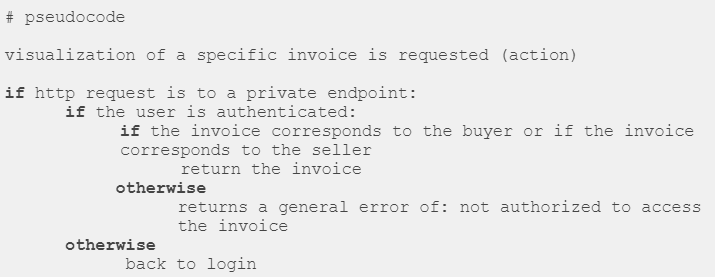Documentación Mercado Libre
Descubre toda la información que debes conocer sobre las APIs de Mercado Libre.
Documentación
Security requirements and validations
Specific requirements
Authentication
Authentication is a process that allows us to know the digital identity of a user (previously registered) and consists of a series of mechanisms that establish that this user is who he/she claims to be. These mechanisms are usually grouped into 3 main categories:
- Something I know (password);
- Something I have (cell phone, authentication token, yubikey);
- Something I am (biometrics).
- The amount of a transaction must not be negative and must have at most two rounding zeros.
- An order number must not be negative and must be integer.
- A last name must not have special or non-printable characters.
- A user`s date of birth must not be less than the year 1900.
- Even if an office documents is well formed, we need to check if it has macros presents with potentially vulnerable or malicious code.
- If we are receiving images, determine whats is the maximum and minimum weight they should have, if we should deleted the matadata, or if it only informationn related to an image.
- If the parameter is directed from a query to a database, it is necessary to parameterize the queries.
- If the parameter we expect is very specific, we must implement regular expressions to validate the data we expect.
- If the parameter is returned to the frontend, additional validations must be implemented such as: encoding or sanitization.
It is the combination of these factors that generates strong authentication.
IMG

Authorization
Authorization is the mechanism by which we control access to a resource, generally based on the previously validated identity of a user. It is important to differentiate this process from authentication: the purpose of authentication is to determine the identity of a user, while the purpose of authorization is to determine whether that identity has sufficient permissions to perform the action it is trying to do. These validations must be implemented in the backend.
There are numerous methodologies for assembling authorization matrices. Among the best known are RBAC, ABAC, ACL, MAC, among others:
IMG

Data validation
Data validation is the practice of validating that all values that do not originate in our application are well structured both semantically and syntactically, prior to processing, storing or transmitting them.
As a general rule and for application security, data validation should be implemented in backend services, since they are flows that cannot be modified by the end user, unlike frontend validations which aim to offer a good user experience.
It is common practice to perform input validation on the frontend (client-side), for example, by not letting the user advance in the flow if he/she does not input something structured as an email in an email field. This is valid from a functional point of view but we have to keep in mind that at a security level, a user can ignore client-side validations and thus send malicious data to applications. Therefore, all input validations that we perform client-side must also be performed server-side.
Syntactic validation
By syntactic validation we mean that the value is correctly formed with respect to the expected data type or structure.
For primitive data types such as float, double, char, boolean, short or long, a recommended strategy is to perform typecasting. The simplified idea is as follows: HTTP is a text-based protocol, so, every basic type value that comes to us in a request is fundamentally a String (or array of chars) with a certain encoding.
In the syntax stage, our goal is to convert the String to the corresponding basic values we are expecting. For example:
If we expect a user_id, which we know is an Int, we can perform a validation of the style:
IMG

Semantic validation
Semantic validation involves understanding whether the value is correct in terms of the context in which it is being used.
In the context of basic data types we can think of examples such as the following:
In the context of complex data types we can think of the following examples:
Warning!
Allow list vs Block list
Within the validation methodologies we can use two main strategies: Block list and Allow List. In simple terms, a blocklist methodology consists of defining and looking for all the unexpected values for each input. For example:
IMG

The general problem with this strategy is that it is complex to know all the dangerous or unexpected characters, and even if we have the whole list today, technologies and standards change, leaving the blocklist possibly outdated and vulnerable.
Instead, it is recommended to use an Allow list strategy that consists of defining the characters or input formats expected by the application. The rationale is as follows, it is much easier to know and define what data I am expecting than to know what data I am not expecting.
Following this strategy, we must be as restrictive as possible, avoiding at all times, to receive input data containing for example: "." or "/".
In case the character list is very permissive because the application requires it, it will be necessary to implement additional controls to avoid undesired behavior.
For example:
General requirements
A summary table is provided below for use as a check-list.
| Control | Descripción |
|---|---|
| Authentication | Validate that all application functionalities are authenticated, i.e. that the request was made by a legitimate user. |
| Authorization | Validate that the previously authenticated user has permissions to access or modify the specific resource. |
| Data validation | Ensure that all values or parameters are semantically and syntactically validated before being used. Pay attention to data types and use an allow list model (allowed values) before a blocklist (not allowed values). |
| Log auditing and logging | Validate if it is possible to answer "Who did what, from where, when and with what result" with the logs available in each application functionality. Avoid "logging" of user information (PII) or confidential information |
| Protection against automated attacks | Validate that all resource modification functionalities (POST, PUT, DELETE) have mechanisms to prevent automated attacks such as brute force or information enumeration. |
| Secrets | Validate that no secrets are hardcoded in code. Secrets include access credentials, authentication tokens, digital certificates, and any other sensitive information. All secrets must be stored and consumed through appropriate mechanisms for handling them. |
| Dependenciesoftware | Validate that the external dependencies do not have vulnerabilities. |
| Applied Cryptography | Validate that the hashing, encryption, signature or random sequence generation schemes are being used correctly and are adequate to solve the particular use case. |
Next: CyberSecurity Best Practices.